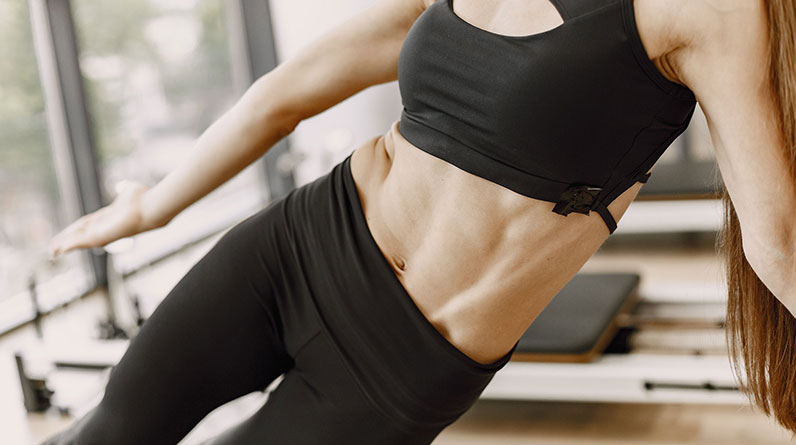
The Benefits Beyond Appearance
Having six-pack abs does more than help you look better; it’s a health benefit that also prevents injuries and lowers back pain.
You need to reduce your body fat percentage substantially below a normal range in order to see six-pack abs. This requires a nutrient-dense diet and consistent physical activity.
1. Strength
Having six-pack abs is a goal for many fitness enthusiasts. Despite the intense aesthetic focus on this area of the body, however, your abs and core do far more for your health than simply give you an attractive appearance. A strong core also helps prevent falls, improves athletic performance, and reduces instances of low back pain.
To achieve six-pack abs, you need to lose body fat, but that doesn’t mean that the muscle under the surface is weak or ill-shaped. Rather, it means you need to achieve a body fat percentage that’s much lower than the recommended range for optimal general health and fitness.
You can train the abs using a variety of exercises, but if you want to build strength in the abdominal region, you’ll need to focus on core exercises that target the rectus abdominis, or “middle abs” as they are often referred to. For instance, rollovers, for which you lie flat on the floor, and hip-ups, for which you lift your legs off the floor and use your lower abs to push them up toward the ceiling, are both great for training your abs.
2. Flexibility
Flexibility is the ability to achieve extended ranges of motion at specific joints, which can be improved through a variety of stretching and strengthening exercises. Various factors influence flexibility, including age, gender, physical activity levels, and injury history.
Despite being a vital part of your fitness routine, it’s often overlooked in favor of more specific measures, such as strength. But the truth is, improving your flexibility can make a huge difference in your performance and even help prevent injuries.
For starters, you’ll experience faster recovery times during and after your workout. Whether you’re doing repetitive movement throughout your day, or if you’re training hard and need to get through each rep without feeling any pain, flexibility can greatly reduce the time it takes for muscle groups to recover.
It’s also an important consideration when it comes to injury prevention because it can reduce the amount of stress placed on tendons and ligaments. Tight muscles can increase the pressure on tendons, causing strain and pain, which isn’t something you want to have.
While it may seem daunting to try and improve your flexibility, it’s actually a relatively simple process that can be accomplished with a few easy changes to your lifestyle. For example, incorporating more movement into your daily life can increase your range of motion, especially when combined with stretches.
In addition, yoga has been shown to significantly improve flexibility and range of motion. Most yoga asanas encourage muscles to lengthen, release and build strength while reducing fascial tightness and neuromuscular inhibition.
To reap the benefits of flexibility, it’s essential to make it a regular part of your routine. Adding just a few minutes of stretching to your daily activities can be the key to dramatically increasing your mobility and lowering your risk of injury.
3. Stamina
Stamina is the combination of strength and energy that allows you to continue an activity, even when you’re tired or drained. It’s important for endurance training and general fitness, but it can also help you improve your mental health too!
There are many ways to build stamina, including running, plyometrics, and weight lifting. But HIIT training is one of the most effective because it forces you to exert maximum force in short bursts.
The key to building stamina is to do short, intense exercise sets several times a week. This will increase your heart rate and your body’s ability to burn fat, which will then provide fuel for your muscles and your body’s systems.
Another way to improve your stamina is to make sure you’re eating a healthy diet. Adding protein, fiber, and vegetables to your meal will help increase your energy levels and keep you going.
Aside from a balanced diet, you can also boost your stamina by doing high-intensity interval training (HIIT). This type of training involves performing a specific set of exercises for a period of time, followed by a break.
For example, you may perform two sets of pushups for 20 seconds each. Then, rest for a couple of minutes. Repeat this process several times, and you’ll soon see a big boost in your stamina.
When you work with a trainer to improve your stamina, they’ll teach you the best exercises and workouts to build it. They’ll also guide you in preparing mentally for your training sessions. They’ll likely recommend a training plan that is built to increase your stamina over time, and ramp up the intensity by 10 percent each week.
4. Confidence
Many fitness enthusiasts and amateurs dream of having washboard abs, and there is no doubt that they are aesthetically pleasing. In addition to attracting attention, they also show that you’re dedicated to your workouts and maintaining a healthy diet.
But can you really benefit from having six-pack abs beyond just looking good? It is possible, but it is not guaranteed.
Body fat levels, genetics, and muscle configuration play a role in how much you see. The front abdominal muscles, known as the rectus abdominis, are prone to hiding under layers of fat that cover them from view.
To get your abs to show, you need to lower your body fat percentage below 14 percent for women and 8 percent for men, according to the American Council on Exercise. But that level of body fat isn’t sustainable for most people, says ACE’s Jennifer Scharff.
Rather than worrying about how your abs look, focus on developing a strong core. This will improve your overall health and prevent injuries.
It will also help you perform the most effective weight training movements, such as squats and deadlifts, better. These are the lifts that require you to use your entire body to generate force, so having strong abs can make them easier to do.
A strong core can improve your confidence and self-esteem, especially if you work to develop it over time. This is not an easy task, but one that can be accomplished if you are committed to making changes in your lifestyle.
5. Energy
If you’ve ever tried to achieve six-pack abs, you’ll know that it can take a lot of hard work and dedication. It’s also possible that you may feel frustrated or discouraged if you don’t see the results you want right away.
However, there are plenty of fit and healthy people who don’t have perfect six-packs or perfectly toned abdominal muscles. There’s no one-size-fits-all body type that can be classified as a “six-pack,” according to Juliet Root, a personal trainer, and Onyx instructor.
While many men and women are able to develop visible abs by dropping their body fat percentage down to a certain level, that’s not always the case. It depends on a variety of factors, including genetics, which determines where you store your fat.
Moreover, your body’s hormones can affect your overall body fat levels, which in turn can influence how easy it is to get a visible six-pack. For example, if you’re more prone to storing fat around your hips, it’s likely that you will see a six-pack much sooner than someone who has more subcutaneous fat in their abdomen.



